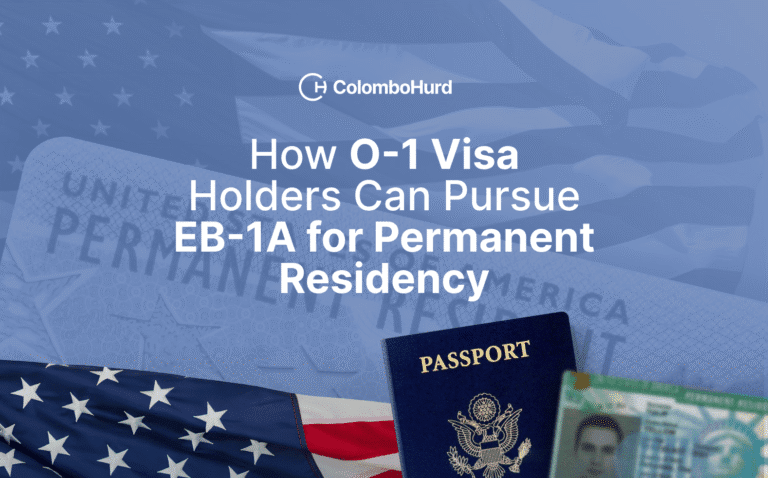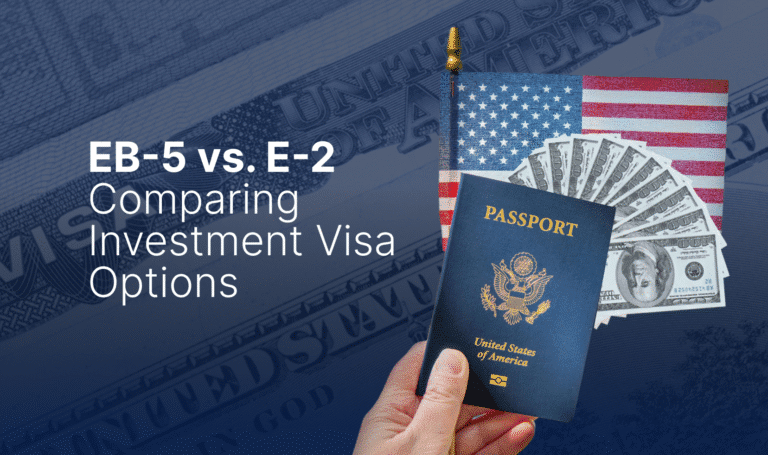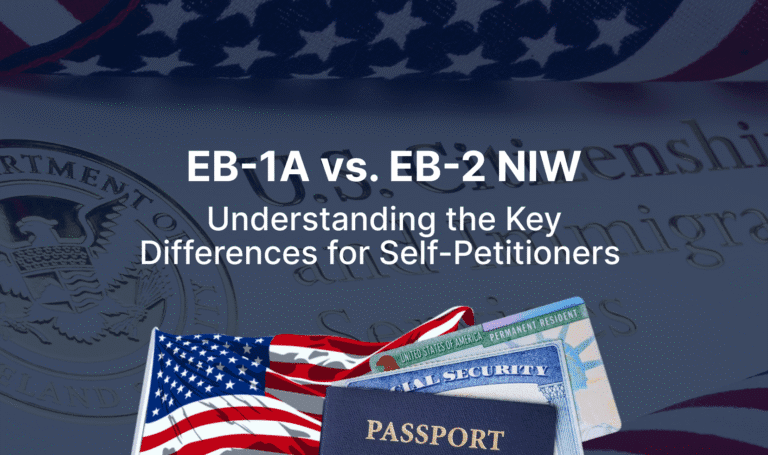If you’re on an O-1 visa, you’ve already been recognized by the U.S. government for your extraordinary ability. This recognition may also put you on the path to the EB-1A green card.
Many accomplished professionals first enter the United States on O-1 visa status to take on a distinguished role or project. With time, achievements grow, records deepen, and permanent residence becomes a realistic goal. For O-1 visa holders, that next step is often the EB-1A immigrant visa category, a green card path for individuals who can show extraordinary ability with sustained national or international acclaim.
This guide explains how O-1 holders can prepare, file, and move through the EB-1A process with practical guidance. The EB-1A and O-1 categories naturally align as pathways for individuals with extraordinary ability.
Step 1: Confirm your EB-1A eligibility
EB-1A petitions rely on evidence of extraordinary ability and sustained acclaim. A one-time major achievement can qualify on its own, but most professionals qualify by meeting at least three out of the ten regulatory criteria and then showing overall merit. Sustained acclaim means showing high achievement over time: a record of past, present, and future accomplishments.
Strong cases document achievements that extend beyond the initial O-1 record: for instance, maintaining a pattern of publications, awards, or critical roles that span several years and show ongoing impact in the field.
For a deeper look at the criteria and how adjudicators evaluate them, review our in-depth look into EB-1A eligibility criteria.
Step 2: Use your time on O-1 to strengthen the record
Time in O-1 status offers an important opportunity to build the very evidence required for EB-1A. This period should be used intentionally to advance professional development and strengthen the overall record of sustained acclaim. Focus on work that results in measurable recognition and independent validation.
Practical actions that help include:
- Publishing peer-reviewed work or authoritative pieces in your field
- Securing national or international awards and shortlists
- Serving as a judge, reviewer, or panelist for respected bodies
- Taking on leading or critical roles in distinguished organizations
- Document high compensation in line with market data
- Tracking significant media coverage and independent profiles
- Showing commercial success for artistic work where relevant
- Joining and participate in professional associations for the field. Even if an organization does not meet the extraordinary ability standard itself, these memberships can create pathways for publication, judging, and leadership. Networking, editing, and contributing to association publications are practical ways to build evidence while advancing professional standing.
It is important to note that quantity alone does not establish extraordinary ability. Four impactful publications in a unique, underrepresented topic can be stronger than hundreds in a crowded field. USCIS looks for impact, not volume. Professionals should focus on distinctive contributions and use platforms like Google Scholar or ResearchGate to track citations, verify reach, and measure the significance of their work.
USCIS places weight on evidence that is independent and verifiable, so recognition from outside employers or sponsors is especially valuable.
Recognition that comes from independent sources, rather than an employer or sponsor, is especially valuable. For recent USCIS guidance on evaluating O-1 evidence, see USCIS Updates Guidance for O-1 Visa Eligibility
Step 3: Plan and File the EB-1A Petition
There is no single timeline that fits every career, but most O-1 holders follow a pattern. The table below summarizes a typical path.
| Step | Action | Purpose |
| 1 | Audit your record against EB-1A criteria | Identify strengths and gaps |
| 2 | Pursue professional activities that build on existing accomplishments and meet the extraordinary ability criteria | Strengthen weaker criteria with targeted achievement |
| 3 | Gather third-party proof | Secure letters, media, awards, and data |
| 4 | Prepare and file Form I-140 | Establish EB-1A classification |
| 5 | Monitor the visa bulletin | Confirm when an immigrant visa is available |
| 6 | File Form I-485 or pursue consular processing | Complete the permanent residence stage |
| 7 | Maintain valid O-1 status until green card issuance | Avoid gaps in work authorization |
I strongly advise professionals to pursue targeted achievements that supplement and strengthen existing evidence, building strategically rather than reactively. EB-1A petitions allow self-filing. Form I-140 is the main petition. Premium processing is available and shortens the adjudication timeline to 15 business days. Evidence should address the criteria, connect achievements to independent recognition, and demonstrate impact in the field. Expert letters should be detailed, specific, and verifiable.
If a visa number is available, Form I-140 and Form I-485 may be filed together. Many professionals choose to maintain O-1 status until green card approval to keep work authorization uninterrupted.
Step 4: Adjustment of status or consular processing
Once the I-140 is approved and an immigrant visa number is available, applicants can move forward through either adjustment of status in the United States or consular processing abroad.
- Adjustment of status (within the U.S.)
File Form I-485. Many individuals add applications for employment authorization and advance parole. This allows continued work and travel during processing. Once the Employment Authorization Document and Advance Parole are issued, those documents must replace O-1 evidence of status for work and travel. At that point, the applicant is no longer in O-1 status but in the process of becoming a lawful permanent resident.
- Consular processing abroad
File Form DS-260 through a U.S. consulate. This route suits individuals who reside outside the United States or who prefer a consular interview timeline.
The choice between these paths depends on individual circumstances and the Visa Bulletin, which tracks immigrant visa availability by country and category. Maintaining O-1 status until consular processing is complete is often the safest route for those outside the U.S., while adjustment of status applicants must anticipate a two-year average timeline for full adjudication.
Step 5: Evidence planning that resonates
A strong EB-1A petition presents a clear story supported by consistent documentation. Consider the following evidence practices:
- Provide independent media profiles that discuss significance, not promotional pieces
- Show judging activity with official invitations, selection criteria and outcomes
- Quantify contributions with citations, adoption, benchmarks, revenue, or audience data.
- Focus on working on unique issues for a greater impact on the field.
- Use google scholar or research gate to centralize publication data, AND to see other professionals working in the field.
- Explain the prestige of awards, selection criteria, and the size of the field considered
- Include organizational context for leadership roles and why the role is critical. Track your impacts- keep copies of innovations, internal recognition, and other measures of success.
- Align expert letters with the criteria you meet and avoid generic praise.
- Explain why your work matters in the broader field, not just to your employer.
- Track every measurable outcome like awards, bonuses, internal recognition, or innovations, and maintain copies of supporting evidence. Professionals should build their own file before leaving an organization, since later access to records is often limited. The strongest petitions show contributions across time: past, present, and future, demonstrating growth and continued relevance in the field.
Step 6: Status maintenance during the process
Keep O-1 valid while EB-1A is pending. If your project term is ending, file timely O-1 extensions through the employer or agent. Coordinate travel plans around pending filings, biometrics, and possible interview dates. Document every status event and keep copies of approvals and entry records.
O-1 is quasi “dual intent,” which means applying for EB-1A does not prevent you from extending O-1 status or reentering the United States while the I-140 is pending. Once you apply for permanent residence you will need to consult with your attorney on the best strategy for maintaining work and travel authorization.
Common Challenges
Professionals considering the transition often make the mistake of reusing their O-1 petition packet with only minimal updates, which rarely satisfies the higher evidentiary standards of EB-1A. Another common issue is relying too heavily on older achievements without presenting more recent recognition or evidence of continued influence in the field.
Weak recommendation letters can also undermine an otherwise strong petition, particularly when the letters lack detail or come from individuals without recognized authority. Some individuals overlook the importance of monitoring the visa bulletin, which can cause them to miss the proper filing window. Finally, allowing O-1 status to lapse before permanent residence is granted creates unnecessary risk and may disrupt employment authorization in the United States.
Frequently Asked Questions
Yes. Premium processing is available for EB-1A I-140 filings. It expedites the classification decision but does not change the availability of immigrant visas. USCIS will act on the case within 15 working days of receipt of the premium processing request.
Premium processing is also available for primary O1 applicants on the adjudication of the I-129. Dependents are not eligible for premium processing, so their adjudications may take longer; plan accordingly when timing status changes.
Concurrent filing is possible if a visa number is available for your category and country of chargeability. Many individuals keep O-1 current until the green card is issued.
International travel without approved advance parole can result in abandonment of a pending I-485.
No. Letters can be from recognized experts anywhere, provided the authors’ credentials are clear, and the letters provide specific, verifiable analysis.
No. The advisory opinion is required for O-1 filings. EB-1A relies on documentary evidence and expert letters rather than a formal advisory opinion.
You wait until the visa bulletin shows the date is current again. Maintain O-1 status or other lawful status during that period when possible.
EB-1A is a self-petition category. A job offer is not required. Continue to work consistently with your area of expertise. It is useful to have professional activities arranged when preparing the petition. This does not have to be a formal job offer.





